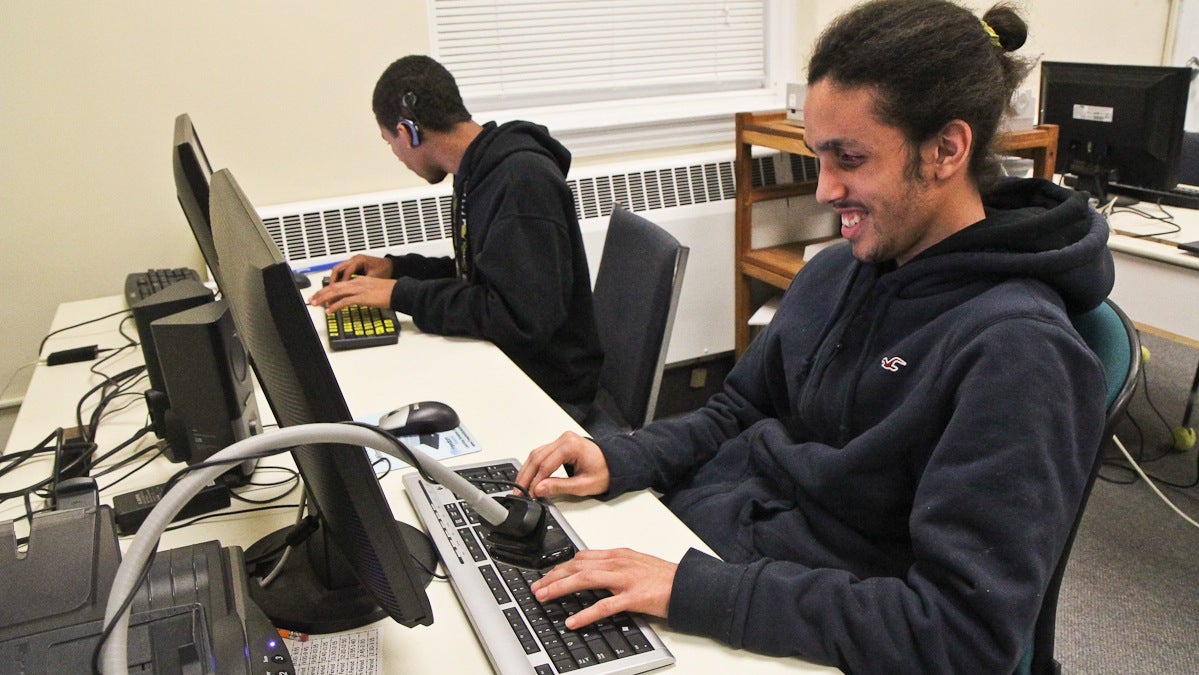Should websites be required to provide better access to the disabled?
Listen
Angel Ayala
Nearly a quarter century after the signing of the Americans with Disabilities Act, many web portals are still challenging to navigate.
It’s either 1983 or 1984, and Austin Seraphin begs his mom to take him to the electronics store to check out an Apple IIe computer.
“She said they were so surprised, they were so shocked. And I said, ‘Yeah, they must have been shocked that a blind person—especially a blind kid—wanted to use a computer.’ And she said, ‘No, they were shocked to have customers,'” he says with a laugh.
The Apple IIe was a big deal in the mainstreaming of computers, but it was a really big deal for seven-year-old Seraphin. The machine was one of the first home units to have a slot for a sound card, allowing special software to read aloud whatever was on the screen.
“It was great for its day…because it was all text, you know,” says Seraphin.
From games and bulletin boards to chat rooms, the early internet was simply words and commands, and a screen reader leveled the playing field for people with disabilities.
“But when Windows became dominant, that’s when we entered a dark age of accessibility,” says Seraphin.
Computer screens began filling up with images and graphics, and the mouse replaced the command line. Screen readers did a decent job keeping up with the changes, according to Seraphin, until the arrival of the World Wide Web.
“That was so revolutionary, because it started bringing this graphical element with these links that they could click on, and move around with the mouse and display images and eventually multimedia,” he says.
Suddenly, screen readers needed more information about the content they were attempting to give voice to. The problem, though, is that website developers weren’t feeding that information consistently in the form of code.
Today, the web remains a hodgepodge of accessible and non-accessible sites for people with disabilities. Some major tech companies have taken the necessarily coding steps to make sure adaptive technologies work properly, while other .coms, .govs and .edus are riddled with unlabelled links and images without descriptions that make surfing near impossible.
Advocates say it’s far past time for the federal government to step in and protect these users by regulating web and mobile accessibility, and they point to the Americans With Disabilities Act as the legal basis.
“This is beyond just mere conveniences like shopping online,” says Chris Danielsen, director of public relations for the National Federation of the Blind.
“This deals with education and employment…being able to do so many things that I just don’t think it is realistic to say in the 21st century that websites don’t have to be ADA compliant.”
Passed in 1990, the landmark civil rights legislation requires businesses, schools and governments to make reasonable accommodations for people with both physical and mental limitations, and prohibits discrimination.
But there’s not a word in the ADA regarding the internet.
“This is a matter of equality,” says Danielsen. “It’s not just a matter of what laws apply.”
On this point, the United States Department of Justice appears to be on his side.
The DOJ is working on regulations to fold the web into the law, spelling out exactly how an ADA-compliant site would function, and to clarify which websites would have to meet those standards. The agency may rely on an industry-adopted set of rules known as the Web Content Accessibility Guidelines 2.0.
DOJ is scheduled to release its regulations in March, though they’ve been delayed several times already.
“We are hoping that they will contain a very robust interpretation of what needs to be covered, but there’s just no way to know at this point, and it is very frustrating that the wait continues,” says Danielsen.
In the absence of laws, lawsuits have been the go-to strategy for disabilities rights groups. In 2006, Target was sued because while their brick-and-mortar stores were accessible, their website wasn’t. In a settlement, the retailer agreed to overhaul its online service. Another major case involved Netflix. In 2012, the National Association for the Deaf prevailed when the video streaming giant agreed to phase in closed captioning.
There’s also been complaints filed against major banks and universities, including Penn State. For a lot of sites, though, it was customers—not courts—that led to improvements.
Five years ago, a group complained to Major League Baseball that much of their online content was difficult to use.
“It was really a great grass roots initiative of baseball fans, particularly visually impaired baseball fans, who wanted that level of access to their games, particularly live games,” says Matthew Gould, with MLB Advanced Media.
He says the company honestly didn’t know the site wasn’t working well for everyone, so when it was brought to their attention, coders made the improvements.
At tech-giant Yahoo, there’s now an entire building on their California campus where people with disabilities test prototypes, identifying bugs before new products hit the market.
“All the Silicon Valley companies really have people dedicated to the task: Paypal and Intuit and Google and Facebook and JPMorgan Chase…so many companies are putting really substantive efforts in, not just Yahoo,” says Larry Goldberg, the company’s director of accessible media.
Those efforts now extend into mobile technology, as smart phones including the iPhone come pre-loaded with screen readers.
Austin Seraphin, who still has his Apple IIe in a box somewhere, now makes his living as a web accessibility consultant, helping companies craft technology that works seamlessly.
“It’s not just about helping the blind or whatever,” says Seraphin. “It is about making a better website for everyone.”
Because, if a site or app is well designed from the ground up, people, no matter their ability, will be more likely to use it, he says.
WHYY is your source for fact-based, in-depth journalism and information. As a nonprofit organization, we rely on financial support from readers like you. Please give today.



